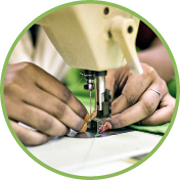 Isn't it intriguing that greening the garment factories of the country with huge investment has done little to fetch fair prices compared to many competing countries?
Isn't it intriguing that greening the garment factories of the country with huge investment has done little to fetch fair prices compared to many competing countries?
A recent report released by the lead think-tank Centre for Policy Dialogue (CPD) finds a commendable improvement in the move to make factories green over the years. The report based on a study titled "Securing Green Transition of the Textile and Readymade Garments Sector in Bangladesh" was carried out on the owners and managers of 403 factories and 4,541 workers in the country. The study found that 69.70 per cent of factories are self-motivated to obtain green certificates. Besides, 54.55 per cent of the owners have taken green initiatives thanks to their marketing strategy, while 39.39 per cent obtained different green certificates for competitiveness in the market. The major areas of green investment by factories included technologies related to energy conservation, renewable energy, building-level energy metre, controlling air and dust pollution, management of solid waste and wastewater and building-level water metre. The study report also attempted to estimate the investment made in this regard. Average green investment in the last five years per factory has been Tk 78.07 million, which is 36.98 per cent of their total investment. Small and medium-sized factories allocate a higher percentage of their total investment -- 44.84 per cent and 53.99 per cent respectively -- towards green initiatives, the study found.
No doubt a praiseworthy job, but at what return? This indeed is a key question. While the factories are making significant efforts to make their production greener and cleaner, the price offered by Western buyers doesn't reflect it. While global garment retailers insist on transforming garment factories into green production units involving substantial costs, there is as yet no sign of even a marginal hike in prices.
Since the incidents of Tazreen fire in November 2012 and Rana Plaza building collapse in April 2013 that shook the entire garment industry with potential threats for the future, the country's readymade garment factories have undergone large-scale renovation works to ensure safety of their workers. The two representative agencies of international buyers - the EU-based Accord and North America-based Alliance, along with local inspection agencies have successfully accomplished the task of factory remediation in respect of, reportedly, eighty per cent of the 5000 garment factories-mostly located in Dhaka and Chottogram.
Accompanying the factory remediation works, there have been a lot of proactive moves by a good number of large factory owners in that they advanced far ahead turning their factories into green factories. This involves a major shift in energy and environmental design of the factories and significant investment in eco-friendly production processes. In a short time, surprisingly indeed, the country topped the list of garment producing countries in the number of full-fledged green factories. The factories received Leadership in Energy and Environmental Design (LEED) certificate from the United States Green Building Council (USGBC). A LEED-certified factory ensures 25-30 per cent less water and energy consumption, and fewer industrial accidents, like fire.
Reports say that around 70 garment factories have received LEED certification from USGBC. Another 280 factories are in the process of getting LEED certification. Among all the exporting countries taken together, Indonesia's position is next to Bangladesh with 50 LEED certified garment factories.
With things better positioned now than ever before, it was expected that international buyers free as they are from the indictment of procuring from unsafe and hazardous production places, will pay a little extra while placing orders to these state-of-the-art factories. Unfortunately, this is not happening. A local daily recently reported that green garment factory owners, who spent huge amounts for setting up these units, are dismayed as their efforts are not being rewarded by international retailers by way of higher prices. It has been learnt that construction cost of these factories is 20-30 per cent higher than the regular ones because of the special design and introduction of newer technology.
It may be noted that consumers in the developed world, backed by consumer rights protection groups, make it a strong point that products like garments, footwear etc must not be sourced from countries where working condition is unsafe. With the transition towards green factories taking place fast, Bangladesh garment factories have been able to make a bold step in improving the overall condition of the workplaces. With the number of green factories on the rise, the situation has not only improved from where it was years ago, but the overall workplace scene is reportedly far better than most competitors.
Under the circumstances, the buyers need to acknowledge this and be willing to pay more. The EU ambassador who was present at the CPD's report release event has reportedly said so. The onus is not only on the government, not just on the industry but also on brands and buyers, he said, suggesting real engagement and partnership.
wasiahmed.bd@gmail.com
© 2026 - All Rights with The Financial Express
